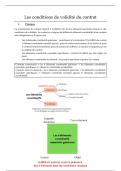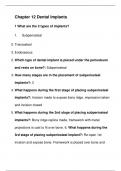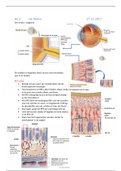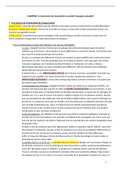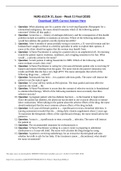UNIVERSITY OF GRONINGEN
FACULTY OF ECONOMICS AND BUSINESS
INCLUDING ANSWERS
RESIT
MACROECONOMICS 1
2009-2010
EBP812A05
EBP813A05 (questions in Dutch)
Tuesday, April 13, 2010
Exam hall 03
9.00-12.00 am
Always motivate your answers. Without a motivation you will not get any
credits. Please use the predefined boxes for your answers.
The answers will be published on Nestor as soon as possible.
,Question 1 (18 points)
This question consists of 6 statements. You are requested to evaluate whether these statements
are right or wrong. You have to give an explanation. For every correct answer you get 3 credit
points. No credit points are given for answers without explanation.
a) The consumer price index (CPI) may overstate inflation because among other things
quality improvements often are not fully taken into account when the basket of goods is
defined.
True. Prices may rise because of quality improvement. In that case only part of the
measured price change reflects a rise in the cost of living.
b) If Dutch households buy new cars in 2010 that have been imported in 2009, Dutch
GDP is unchanged in the Dutch National Accounts both in 2009 and 2010 (other things
equal).
True. There is no production of cars in the Netherlands. Measured expenditures do not
change either: in 2009 the import of the cars implies negative net exports and positive
investment (in inventories); in 2010 the selling of cars implies negative investment
(inventories decrease) and positive consumption.
c) Frictional unemployment can be reduced by lowering minimum wages.
False. Frictional unemployment exists when, at a given wage rate, there are both vacancies
and unemployed. Lowering minimum wages does not increase the search activity of
unemployed and employers.
d) Suppose that an increase in the cost of services provided by government reduces
aggregate demand in the short run.
Statement: According to the quantity equation, with a fixed nominal money supply and
constant income velocity, this cost increase does not shift the aggregate demand curve.
True. The drop in aggregate demand is caused by an upward shift of the short-run aggregate
supply curve (movement along the AD-curve).
, e) Suppose that consumption not only depends on disposable income, but also on the
interest rate (the higher the interest rate, the lower consumption). Suppose also that
higher savings in the rest of the world decrease the world interest rate.
Statement: The IS*-curve of a small open economy shifts outward, and the shift is
bigger than in the standard Mundell-Fleming model (in which consumption is not
depending on the interest rate).
True. In the standard Mundell-Fleming model, the IS*-curve only shifts outward because
investment increases (given the exchange rate). Here the IS*-curve shifts more because
consumption increases.
f) Suppose that the government debt at the beginning of a certain year is 1000, the
nominal deficit during that year is 200, and inflation is 5 per cent.
Statement: The real deficit then is 150.
True. The real deficit is the nominal deficit corrected for inflation (200 − 0.05×1,000).
Question 2 (18 points)
Suppose a small open economy is described by the long run classical model below.
Supply: YS = K 0.5 L0.5
Demand: YD = C + I + G + NX
Consumption: C = 0.75(YS − T ) + 25
Investment: I = 170 − 10r
Net exports: NX = 40 − 10ε
Government expenditures: G = 50
Taxes: T = 70
Capital: K = 900
Labour: L = 100
World interest rate: r* = 3
Capital mobility: r = r*
Equilibrium goods market: YD = YS
Where r is the real interest rate, and ε the real exchange rate.
FACULTY OF ECONOMICS AND BUSINESS
INCLUDING ANSWERS
RESIT
MACROECONOMICS 1
2009-2010
EBP812A05
EBP813A05 (questions in Dutch)
Tuesday, April 13, 2010
Exam hall 03
9.00-12.00 am
Always motivate your answers. Without a motivation you will not get any
credits. Please use the predefined boxes for your answers.
The answers will be published on Nestor as soon as possible.
,Question 1 (18 points)
This question consists of 6 statements. You are requested to evaluate whether these statements
are right or wrong. You have to give an explanation. For every correct answer you get 3 credit
points. No credit points are given for answers without explanation.
a) The consumer price index (CPI) may overstate inflation because among other things
quality improvements often are not fully taken into account when the basket of goods is
defined.
True. Prices may rise because of quality improvement. In that case only part of the
measured price change reflects a rise in the cost of living.
b) If Dutch households buy new cars in 2010 that have been imported in 2009, Dutch
GDP is unchanged in the Dutch National Accounts both in 2009 and 2010 (other things
equal).
True. There is no production of cars in the Netherlands. Measured expenditures do not
change either: in 2009 the import of the cars implies negative net exports and positive
investment (in inventories); in 2010 the selling of cars implies negative investment
(inventories decrease) and positive consumption.
c) Frictional unemployment can be reduced by lowering minimum wages.
False. Frictional unemployment exists when, at a given wage rate, there are both vacancies
and unemployed. Lowering minimum wages does not increase the search activity of
unemployed and employers.
d) Suppose that an increase in the cost of services provided by government reduces
aggregate demand in the short run.
Statement: According to the quantity equation, with a fixed nominal money supply and
constant income velocity, this cost increase does not shift the aggregate demand curve.
True. The drop in aggregate demand is caused by an upward shift of the short-run aggregate
supply curve (movement along the AD-curve).
, e) Suppose that consumption not only depends on disposable income, but also on the
interest rate (the higher the interest rate, the lower consumption). Suppose also that
higher savings in the rest of the world decrease the world interest rate.
Statement: The IS*-curve of a small open economy shifts outward, and the shift is
bigger than in the standard Mundell-Fleming model (in which consumption is not
depending on the interest rate).
True. In the standard Mundell-Fleming model, the IS*-curve only shifts outward because
investment increases (given the exchange rate). Here the IS*-curve shifts more because
consumption increases.
f) Suppose that the government debt at the beginning of a certain year is 1000, the
nominal deficit during that year is 200, and inflation is 5 per cent.
Statement: The real deficit then is 150.
True. The real deficit is the nominal deficit corrected for inflation (200 − 0.05×1,000).
Question 2 (18 points)
Suppose a small open economy is described by the long run classical model below.
Supply: YS = K 0.5 L0.5
Demand: YD = C + I + G + NX
Consumption: C = 0.75(YS − T ) + 25
Investment: I = 170 − 10r
Net exports: NX = 40 − 10ε
Government expenditures: G = 50
Taxes: T = 70
Capital: K = 900
Labour: L = 100
World interest rate: r* = 3
Capital mobility: r = r*
Equilibrium goods market: YD = YS
Where r is the real interest rate, and ε the real exchange rate.

